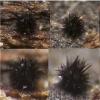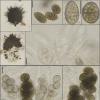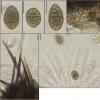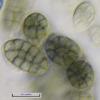
24-11-2025 15:23
Arnold BüschlenHallo, auf einer offenen Kiesfläche am Rande ein

23-11-2025 11:16
Bohan JiaHi, I found small discs growing on dead stem of

21-11-2025 10:56
 Christopher Engelhardt
Christopher Engelhardt
Very small (~0,5 mm) white ascos, found yesterday

21-11-2025 11:52
Jean-Luc RangerBonjour à tous, on voit toujours 2 espèces areni
Bitunicate, hairy pyreno with muriform spores
Gernot Friebes,
09-03-2010 23:17
I were not able to determine this very beautiful species despite it's striking characters. The ascomata are minute, black, more or less soft, hairy and superficial. The spores are (18,5)21-23(25) x 12-13(14) and muriform with a thicker middle septum. The hairs are straight, slightly thick walled, dark brown except for the light brown apex. The asci are bitunicate, 8-spored and inverted clavate. It grew on a dry branch of Quercus, soc. Orbilia coccinella, Acanthostigma minutum.
Could you help me?
Best wishes,
Gernot
Gernot Friebes,
09-03-2010 23:17
Hans-Otto Baral,
09-03-2010 23:31
Hans-Otto Baral,
09-03-2010 23:32
Hans-Otto Baral,
09-03-2010 23:32
Alain GARDIENNET,
10-03-2010 07:14
Re:Bitunicate, hairy pyreno with muriform spores
My ideas also round around Dictyotrichiella and so, Capronia, but the spores of Gernot were different of the species that I know. It looks like your testudiformis, really.
Alain
Alain
Gernot Friebes,
10-03-2010 15:20
Re:Bitunicate, hairy pyreno with muriform spores
Hi Zotto,
thanks for showing your fungus, however I don't think it fits totally with my fungus. Your fungus seems to have spores with the typical "Dictyotrichiella/Capronia-colour", so a mixture of brown, grey and green. The spores of my fungus, however, are darker and only brown. Furthermore, the spores of my fungus are more muriform because the spores of C. testudiformis have clearly visible transversal septa while in my fungus the spores are transversally septate only in the middle, the rest is very muriform. Also your spores seem to be to small, can you confirm that? Finally, my fungus lacks a hemiamyloid reaction in IKI, in KOH + IKI and in Melzer's.
But still, some similarities are clearly existing.
Best wishes,
Gernot
thanks for showing your fungus, however I don't think it fits totally with my fungus. Your fungus seems to have spores with the typical "Dictyotrichiella/Capronia-colour", so a mixture of brown, grey and green. The spores of my fungus, however, are darker and only brown. Furthermore, the spores of my fungus are more muriform because the spores of C. testudiformis have clearly visible transversal septa while in my fungus the spores are transversally septate only in the middle, the rest is very muriform. Also your spores seem to be to small, can you confirm that? Finally, my fungus lacks a hemiamyloid reaction in IKI, in KOH + IKI and in Melzer's.
But still, some similarities are clearly existing.
Best wishes,
Gernot
Hans-Otto Baral,
10-03-2010 16:39

Re:Bitunicate, hairy pyreno with muriform spores
Hi Gernot
you seem to be right, but the two fungi are really very similar. The spores in C. testudiformis are more regular and parallel in their cells, in some spores I see they are similar as in yours, and we named the species because the cells go round like on the tortoise carapace.
You are right with the spore colour. I noted mainly olive-grey or green-grey, also grey-brown.
Maybe also the hair colour is more blackbrown in testudiformis.
I looked up my measurements, and they are actually below yours, especially the width:
(12,5-)14-18(-23)/9-11.5 µm
And the absence of an iodine reaction sounds convincing. The hemiamyloid reaction in Capronia is quite frequent though not in every species. It was totally overlooked by the Melzer users, obviously because they did not pretreat with KOH. In this respect Capronia is possibly closely related to Epibryon for which the hemiamyloid reaction is well reported because the genus is more studied by workers coming from lichens.
Zotto
Gernot Friebes,
10-03-2010 22:02
Re:Bitunicate, hairy pyreno with muriform spores
Hi Zotto,
so it will be another indeterminate pyreno with really striking characters. Still your fungus is close to mine and I will keep my eyes open for collections of C. testudiformis. It's still possible that our finds are related, who knows.
Best wishes,
Gernot
so it will be another indeterminate pyreno with really striking characters. Still your fungus is close to mine and I will keep my eyes open for collections of C. testudiformis. It's still possible that our finds are related, who knows.
Best wishes,
Gernot







